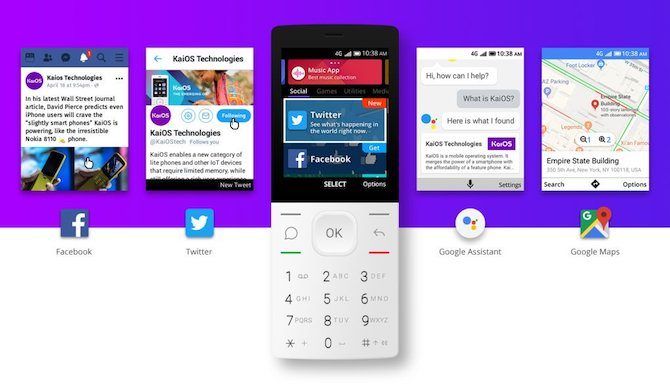
Smartphone sales and the growth of online services have begun to stagnant throughout the globe. In the search for the next chunk of users, companies like Google are being forced to explore new avenues.
One of those is reaching regions where smartphones are still largely inaccessible. A new mobile operating system called KaiOS promises to solve that conundrum. It has already outpaced iOS in emerging countries such as India and bagged funding of $22 million from Google.
So what is KaiOS and why are so many companies pushing for it?
What Is KaiOS?
KaiOS is a mobile operating system for feature phones. It’s built on top of Boot to Gecko, a community-driven successor to Firefox OS. Since it’s a web-based platform, KaiOS doesn’t need a lot of power to run and has a minimum memory requirement of just 256MB.
KaiOS promises to bring modern apps such as WhatsApp to people who had never owned a smartphone. Thus, its interface is designed for the so-called dumbphones with physical keys and non-touch screens. To ensure data-oriented companies are able to gain from this, KaiOS does offer all the connectivity options including 4G/LTE, NFC for payments, Dual-SIM compatibility, and Wi-Fi.
KaiOS-powered feature phones are priced aggressively too since manufacturers don’t need to worry about high-end specifications. Its biggest success, Reliance’s JioPhone, sells in India for about $20.
How KaiOS Differs
The reason why KaiOS grew in popularity among tech companies is its HTML5 app store. That has allowed developers to easily build powerful web apps for KaiOS. The majority of other feature phones today come with proprietary Java-based software and hence, demand more resources for creating dedicated apps.
In addition, KaiOS has an open environment. As such, it’s available across the globe from several brands like Nokia, Reliance, Alcatel, and more. So companies can simply build one app and upload it to the KaiOS app store for widespread distribution in emerging countries.
Which Apps Does KaiOS Support?
KaiOS’ app store hosts tens of titles, some of which you might be familiar with. These apps, of course, don’t offer the same set of functionality they do on smartphones. Only the basics are covered. For instance, you can’t live-stream from the Facebook or Twitter apps.
At the time of writing, KaiOS offers:
- YouTube
- Google Maps
- Google Assistant
- Google Search
- WhatsApp (OEM dependent)
- The Weather Channel
- A few Gameloft games like Danger Dash and Real Football Runner
The store has a handful of other generic apps which are developed by KaiOS itself. There’s one for checking the weather called KaiWeather, QR Reader for scanning codes, and more.
What Is Google and Facebook’s Interest in KaiOS?

Google and Facebook were among the first to port their services to KaiOS. But why are they bothering with bringing their apps to feature phones at all?
The answer to that is straightforward. Big tech companies primarily generate revenue from their advertising network. More users translate to more data and advertisers. With smartphone sales plummeting, these giants are turning to feature phones in a hope to expand their user base.
By signing up early, they’re essentially trying to get a head-start before the competition catches up. They want to be the first online destination for KaiOS’ demographic which will mostly include users who are using the internet for the first time.
Both Google and Facebook have, over the years, introduced new features and language support for emerging countries. Google Assistant, for instance, can now talk in Hindi, the most widely-used Indian language.
Google has gone even as far as investing over $20 million in KaiOS and secured the role of the default voice assistant. Phones such as the JioPhone 2 also have special hardware buttons for invoking the Assistant. Plus, KaiOS has added deep-level integrations.
So you can simply say “message Dave on WhatsApp” or “Check in on Facebook” and the software will take care of the rest.
Who Is KaiOS For?
KaiOS’ target audience is the entry-level segment and places where smartphones still haven’t gone mainstream. KaiOS is also meant for customers with low literacy rates who find it difficult to navigate on a touchscreen. The available apps have been developed keeping that in mind and can be completely operated through physical buttons.
What’s more, KaiOS phones are excellent options for people who’d like to detox and break their smartphone addiction. You’ve got all your essential apps like Google Maps but the small display and keypads will restrict you from spending too much time on them.
Another use case for such phones is kids. You can buy a KaiOS feature phone without worrying about them staring at their phones constantly. Compatibility with the majority of leading online services, means they can stay connected with you and their friends.
Senior citizens will find KaiOS appealing as well. It’s simple, can be connected to the internet for apps like WhatsApp, and won’t overwhelm them with constant alerts and popups.
Best KaiOS Phones to Buy

If you’re interested in buying a KaiOS phone, you have a few options depending on where you live. Here are the best KaiOS phones with their availability:
- Alcatel Go Flip 2 (U.S.A., Canada)
- JioPhone 2 (India)
- HMD Global Nokia 8110 (most countries except for the U.S.A.)
- Cat B35 (Europe)
But for people aren’t necessarily interested in KaiOS, there are many other feature phones to consider.
Turn an Android Phone Into a Dumb Phone
Backed by major companies and boasting an open platform, KaiOS certainly seems like the future of feature phones. But for people looking into dumb phones to take a break from their smartphone, there’s a better option.
One that doesn’t require you to invest in a new phone and still experience the limitations. Here’s how to turn a smartphone into a dumb phone.
Read the full article: What Is KaiOS and Why Is It the 3rd Most Popular Mobile OS?
Read Full Article
No comments:
Post a Comment